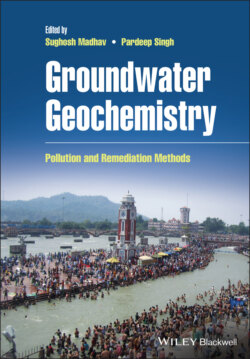Читать книгу Groundwater Geochemistry - Группа авторов - Страница 61
2.5.3.6 Nanofiltration
ОглавлениеOne more removal method for fluoride is nanofiltration which decreases hardness of water with the help of membranes having high retention capacities for charged particles like bivalent ions. Nanofiltration has been considered as the optimum membrane process for eliminating fluoride having this inherent property of specific membrane selectivity (Tahaikt et al. 2007). Many researchers have shown successful elimination of fluoride with the help of the nanofiltration method. Reports suggest that nanofiltration membranes have better success in elimination of fluoride from polluted drinking water in comparison to LPRO (low‐pressure reverse osmosis) membranes. One study reported two commercially available nanofiltration membranes: NF‐90 and NF‐270, in which NF‐270 reduces the concentration of fluoride from 10 to 1.5 mg/L whereas NF‐90 decreases the concentration from 20 to 0.5 mg/L. The presence of anions like bicarbonates exert no noticeable negative effects on the purification process whereas the elimination of fluoride reduces under acidic condition (Hoinkis et al. 2011). According to the study of Bejaoui et al. (2014), successful elimination of fluoride has been reported utilizing reverse osmosis comparing against NF‐90 considering different parameters like pH, ionic strength, feed pressure, and fluoride concentration, as well as nature of cations present along with fluoride. The results revealed that optimization of fluoride removal was done at higher pH as enhancing overall negative charges of membrane has been tested (Bejaoui et al. 2014). The study of Emamjomeh et al. (2018) shows a lab‐scale study of nanofiltration membrane (FILMTEC‐NF90‐4040) using a pilot plant: fluoride removal from contaminated water with concentration lying between 1.50 and 2.17 mg/L. The effectively considered parameters were pressure (between 4 and 12 bars) and temperature (between 10 and 30 °C). Results revealed minimum and maximum removal percentage of fluoride, i.e. 30 and 70%, respectively. One other point brought into light was that increasing pressure and temperature enhanced the performance of fluoride removal and membrane permeate flow rate (Emamjomeh et al. 2018).
According to the study of Van der Bruggen et al. (2008), membrane fouling, chemical resistance, and insufficient separation limited lifetimes, as well as rejection, are some significant disadvantages of the nanofiltration method that increase the financial input of the method. The production of fouling that should be collected and disposed off is also considered as one main disadvantage of this method. One study shows the comparison between NF5 and NF9, two commercial nanofiltration membranes for removing fluoride from groundwater (Nasr et al. 2013). The concentration of fluoride in purified water using NF5 and NF9 nanofiltration membrane was found to be 1.45 and 0.38 mg/L, respectively. Mainly, NF5 and NF9 membranes successfully removed higher amounts of divalent anions from water but smaller ions could be removed more effectively in comparison to others. The reason behind this could be the salvation energy of smaller ions. Results also revealed that chlorine ions penetrate the NF5 and NF9 nanofiltration membrane faster than fluoride. BW30 and NF90 nanofiltration membrane can successfully eliminate fluoride, reducing the concentration from 417.9 to 1.5 mg/L (Shen and Schäfer 2014). According to the reports, calcium carbonate is the main fouling component on membranes of nanofiltration. Recovery of nanofiltration membranes could be achieved by using the citric acid and ammonia cleaning method (Wei‐fang et al. 2009).
